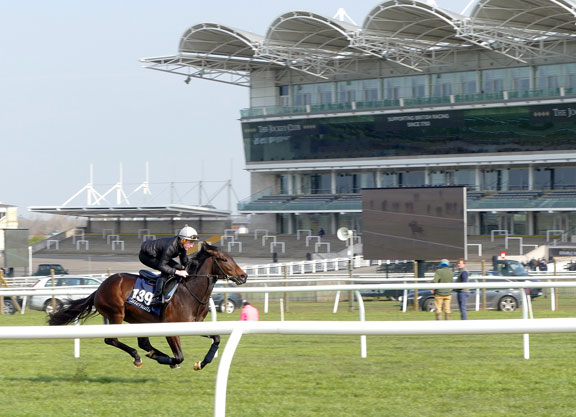By Chris McGrath
NEWMARKET, UK–With the breeze-up calendar this year lurching straight from the blue-collar to the blueblood, it's not easy to read the barometer. Will the Tattersalls Craven Sale take its cue from the uplifting spring sunshine that favoured the youngsters who exhibited their wares on the Rowley Mile yesterday; or from the residue of winter that laced the icy headwind into which they galloped?
Last year, consignors arrived in Newmarket reeling. They had endured a particularly dispiriting start at Ascot, where only half those into the ring managed to find a new home, and found little respite in the intermediate market at Doncaster. This time round, however, the latter sale has been pushed back to later in the month. And it would be rash to treat a sale as different in emphasis as the one staged at Ascot a couple of weeks ago as any kind of signpost, for better or worse, to the likely trade when the first of two evening sessions is staged after racing concludes up the road on Tuesday.
Nonetheless consignors enter the fray with guarded optimism, recognising that there were lessons to be learned last year, and hoping that a new bonus scheme will help their cause.
There was a consensus last year that the sector had become bloated, partly thanks to those opportunists–emboldened by the headline coups of those specialists whose expertise had driven a boom in the market–who “dumped” unsold yearlings on the breeze-ups. Even this sale expanded its catalogue, from 152 to 172, but has been trimmed back to 147 before withdrawals this time.
John Cullinan of Horse Park Stud, who has earned so many plaudits for his work heading the Breeze-Up Consignors' Association, knows that it can be tough for yearling vendors just to write off a hit–for the very good reason that he is also one himself. “But people were losing sight of the fact that this is a specialist sector,” he said. “Just because a yearling is unsold doesn't necessarily mean it will be suitable for the breeze-ups. When we make those decisions, as yearling vendors, it's based on the horse.
“Remember the breeze-ups were never a mainstream activity. The breeze-ups were a way for trainers to top up their 2-year-old stock for the current season, typically adding a couple more provided what they already had at home was paid for. The sector was never capable of absorbing the kind of numbers that ended up in the system last year.”
Tattersalls have certainly done their bit, introducing a £15,000 bonus scheme modelled on the success of its £25,000 Book I incentive at the October Sale. Ascot, likewise, had come up with a new carrot, in a £100,000 bonus for any graduate that proceeds to win at the Royal meeting. So while the postponement of the Doncaster sale removes a wider base for judging the market's morale, Cullinan feels the signs are positive.
“There has been a correction, both on the sales companies' side and the consignors' side,” he said. “Numbers have been tightened up, which needed to happen. Ascot cut back considerably, because they had too many last year when the clearance rate was very poor. I think they've cleverly created an identity for that sale, as a place to find your early 2-year-old; coupled with the bonus, which was a good marketing ploy, the clearance rate was much better.”
Admittedly the increased traffic at Ascot made it hard for the median to recover. But this sale is a whole different ball game, with many lots pinhooked for sums far greater than that given for the top lot at Ascot. There will be plenty of interest, for instance, in the American Pharoah colt consigned by jockey John Egan and his Alliance Bloodstock team as lot 29–not least after an impressive success by the Triple Crown winner's first runner in Ireland last week. This half-brother to Group 3 winner and G2 Queen Mary S. runner-up Shumoos (Distorted Humor) was bought for $375,000 at Keeneland last September and Egan will be hoping for another exciting day, having pinhooked $270,000 yearling Global Prospector (Scat Daddy)–a striking debut scorer at Wolverhampton last month–through Mocklershill when he realised 800,000gns here last year.
But the poster girl for the 2018 sale, adorning the back of the catalogue, is La Pelosa (Ire) (Dandy Man {Ire}), who was sold to Godolphin by Tally-Ho Stud for 280,000gns and proceeded to win the GI Natalma S. at Woodbine five months later.
As one consignor put it, you seldom get any pleasant surprises from a breeze. The most you can hope is that they do themselves justice according to what you have seen at home, and that you get no reaction–in the shins or elsewhere–to what were pretty firm conditions yesterday for those adolescent limbs.
Needless to say, the timing spreadsheets will have their usual impact at the top of the market–whatever agents might claim about treating the clock as just one among umpteen factors–but at least disaster was averted when Norman Williamson's Invincible Spirit (Ire) colt (lot 122) was unable to stretch out because of a broken rein. The Oak Tree Farm consignor was relieved that the colt showed such a sensible disposition that he was able to regroup, after an hour's rest, and show what he could do.
“And he breezed well,” Williamson said. “I'm very hopeful: I have four nice colts by the right sires. That Invincible Spirit is the only one in the sale, and the same goes for a beautiful horse by Farrh (GB) [lot 41]. And we've a very quick, sharp 2-year-old by Dark Angel (Ire) [lot 127], who breezed very well, and a Kodiac (GB) with a very good pedigree [lot 117, out of a group-winning sister to Classic scorer King Of Kings (Ire) (Sadler's Wells)]. All ours did what we thought they would, and they all moved well, which is a big help. They're in good shape, so fingers crossed.
“The whole sector has tightened up a bit on last year and, while it's hard to read [this sale] after Ascot, it looked like there was trade there: plenty of horses being sold for £20,000-£30,000. But here will tell a lot about the future. There are well-bred horses that cost a bit of money, and the standard looked good out there. It was quite quick ground, but there'd be no excuses on it for Flat horses; and while there was the headwind it didn't inconvenience anyone, because it was the same all the way through.”
Cullinan, for his part, was largely happy enough with his team–as usual presented in partnership with Roger Marley of Church Farm.
“It was the usual mixed bag,” he said. “We do have one very smart horse there, lot 80, a naturally quick 2-year-old by Tagula (Ire). But he changed his legs half a dozen times in the Dip. So he didn't breeze quite as well as we would have liked, but our opinion of the horse hasn't changed. We've two Kodiac colts who aren't five-furlong horses, they're seven-furlong horses, but a nice horse is a nice horse and we think they're racehorses [Lots 45 & 108]. Like the Tagula, the Dandy Man [lot 133] is also ready to rock, so hopefully there will be punters out there for them. And we've a filly, another Kodiac, who again won't be a Queen Mary filly [lot 54] but she'll win her races and has a residual value with a good book and a good physical, so hopefully she'll have her admirers.”
His faith in the Tagula colt typifies the scenario in which a bond of trust between consignors and past clients can be worth even more in this sector than is the case with yearlings or foals.
“Yes, vendor input can be much more influential because, by and large, we know what we have,” Cullinan said. “From seeing them on a daily basis, we know which horses are going to be trainable. All we hope is that they show on the day what we think they can do. They never find an extra leg here!”
And that takes us back to his original point. This is a highly specialised business, and you can't chuck just any yearling into the process. “Breeze-up consignors know what might work and what won't,” Cullinan said. “But it's tricky. We've a lot of risks involved. Between us we have spent £90-million over the last four years and, typically, this sale here and the one at Arqana would have about £6-7 million apiece [of stock] coming in. So there's a lot at stake. Thankfully, we've very good people at it and the results on the track have been very, very good.
“So we just hope people recognise the way we're adding huge value to the raw material that is your yearling. We show soundness, ability, you can listen to their wind, see their action. But in doing so we're also exposing the ordinary beasts. So we're taking 20% of the yearling market, sorting out the good ones and culling the bad ones. That makes it a very valuable selection process for our customers.”
Not a subscriber? Click here to sign up for the daily PDF or alerts.






